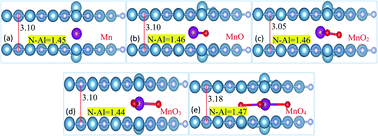Tailoring spintronic and opto-electronic characteristics of bilayer AlN through MnOx clusters intercalation; an ab initio study
Abstract
Adopting ab initio density functional theory (DFT) technique, the spintronic and opto-electronic characteristics of MnOx (i.e., Mn, MnO, MnO2, MnO3 and MnO4) clusters intercalated bilayer AlN (BL/AlN) systems are investigated in this paper. In terms of electron transfer, charge transfer occurs from BL/AlN to the MnOx clusters. MnOx clusters intercalation induces magnetic behavior in the non-magnetic AlN system. The splitting of electronic bands occurs, thus producing spintronic trends in the electronic structure of BL/AlN system. Further, MnOx intercalation converts insulating BL/AlN to a half metal/semiconductor material during spin up/down bands depending upon the type of impurity cluster present in its lattice. For instance, Mn, MnO and MnO2 intercalation in BL/AlN produces a half metallic BL/AlN system as surface states are available at the Fermi Energy (EF) level for spin up and down band channels, accordingly. Whereas, MnO3 and MnO4 intercalation produces a conducting BL/AlN system having a 0.5 eV and 0.6 eV band gap during the spin down band channel, respectively. During spin up band channels these systems behave as semiconductors with band gaps of 1.4 eV and 1.2 eV, respectively. In terms of optical characteristics (i.e., absorption coefficient, reflectivity and energy loss spectrum (ELS)), it was found that MnOx intercalation improves the absorption spectrum in the low electron energy range and absorption peaks are observed in the 0–3 eV energy range, which are not present in the absorption spectrum of pure BL/AlN. The static reflectivity parameter of BL/AlN is increased after MnOx intercalation and the ELS parameter obtains significant peak intensities in the 0–2 eV energy range, whereas for pure BL/AlN, ELS contains negligible value in this energy range. Outcomes of this study indicate that, MnOx clusters intercalation in BL/AlN is a suitable technique to tailor its spintronic and opto-electronic trends. Thus, experimental investigation can be carried out on the systems discussed in this work, so as to fabricate practical layered AlN systems that are functional in the field of nano-technology.



 Please wait while we load your content...
Please wait while we load your content...